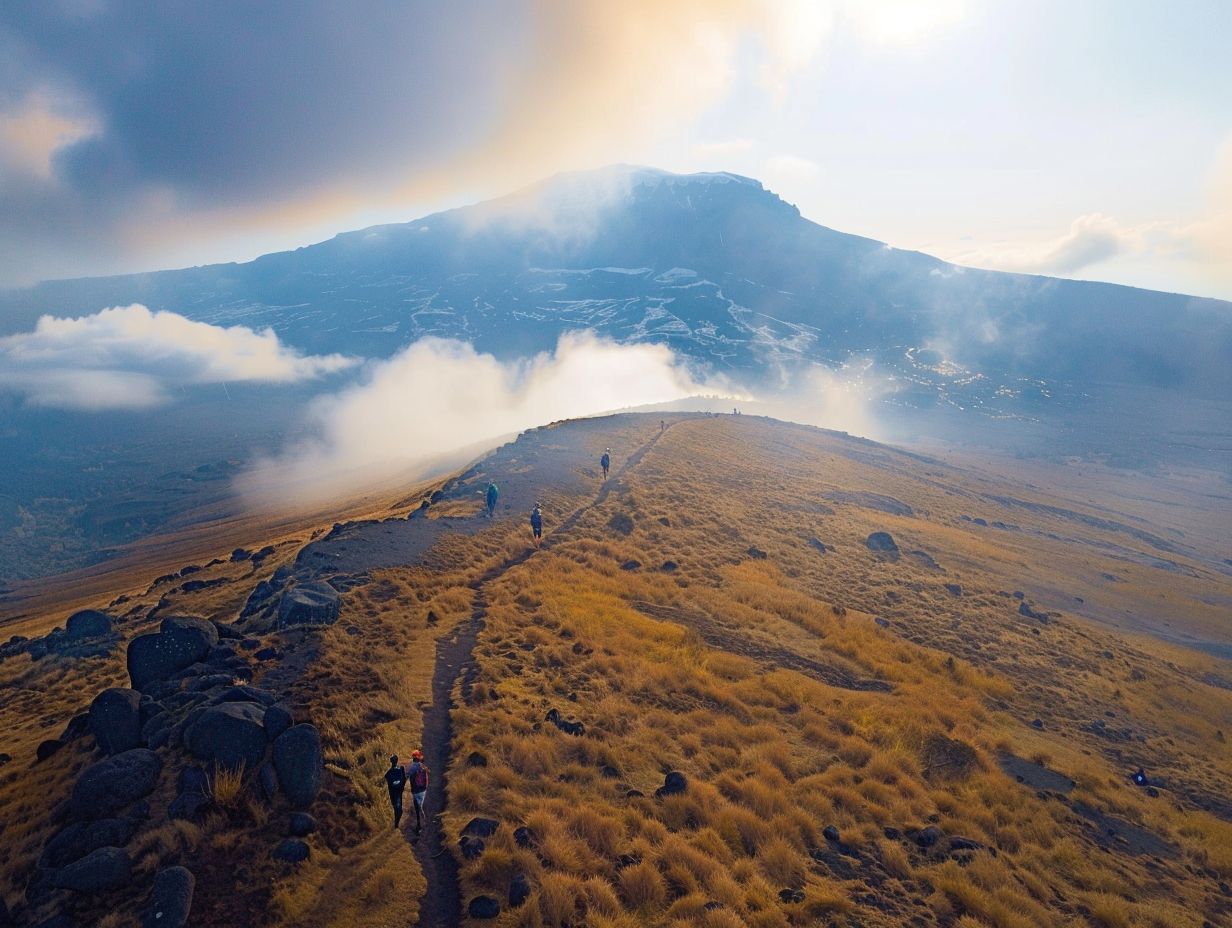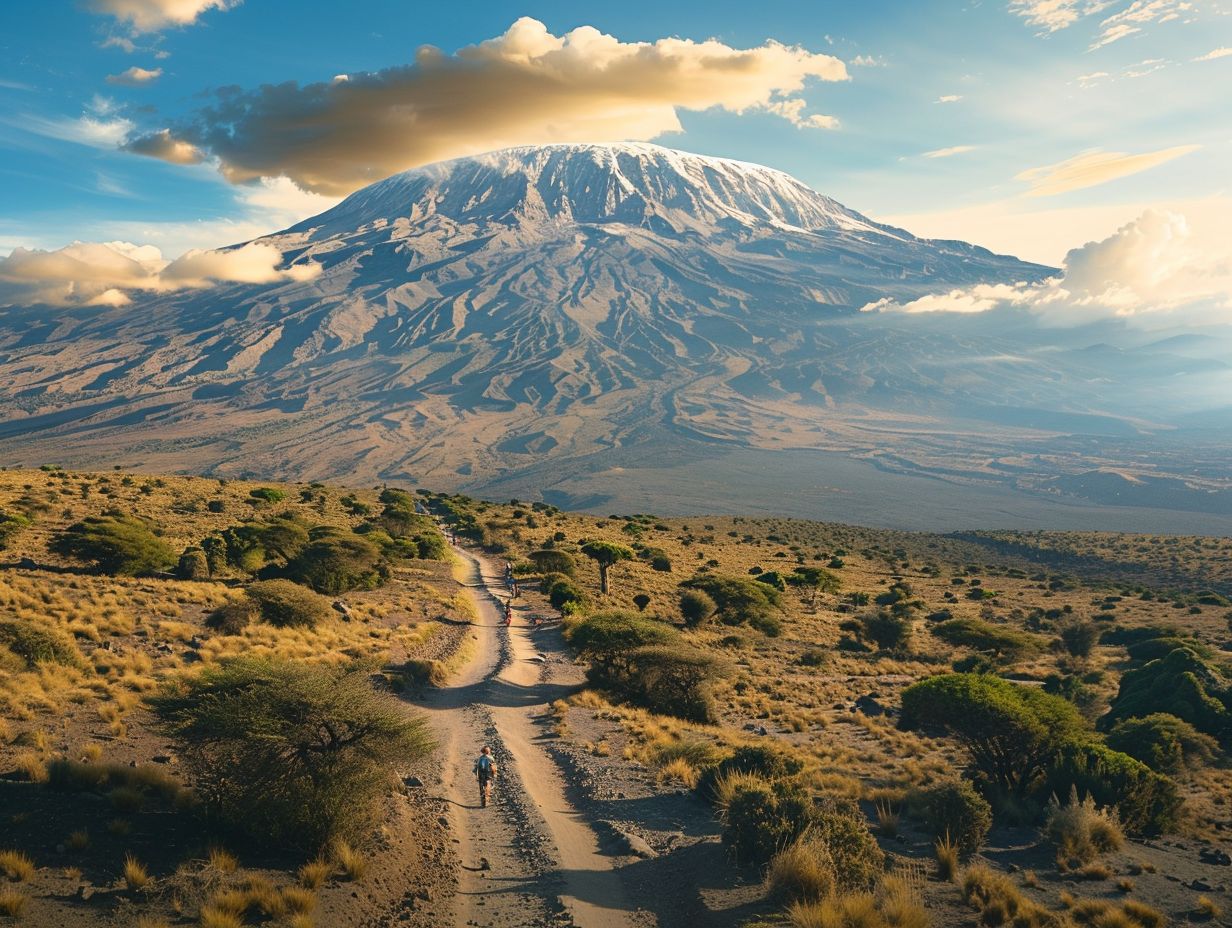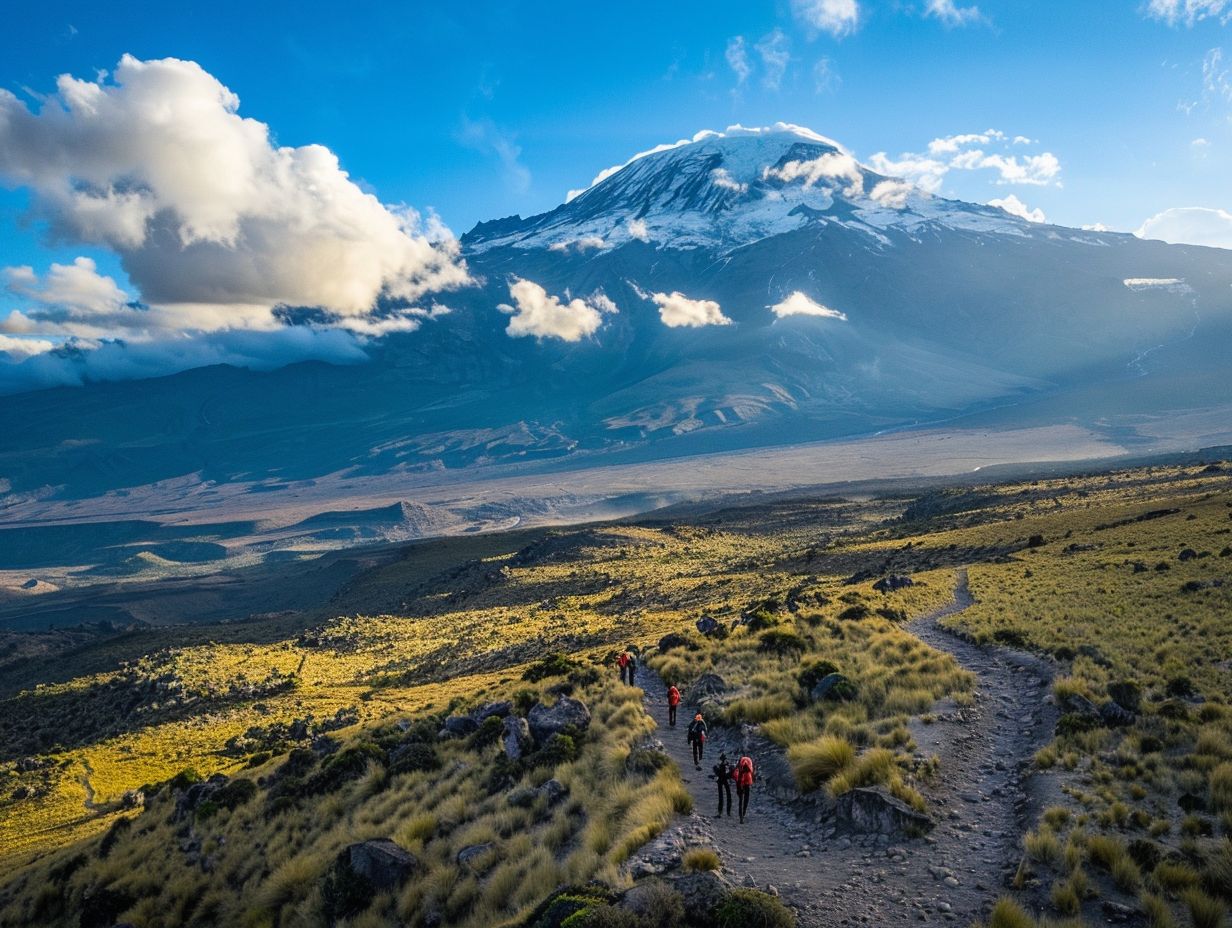
Have you ever wondered about the death rate on Kilimanjaro?
In this article, we will explore the average number of deaths per year on the mountain and compare the death rate to other popular peaks.
We will also delve into the causes of death on Kilimanjaro, including altitude sickness, falls, and medical emergencies.
We will discuss who is most at risk on the mountain and provide tips on minimizing the risk of death, such as proper acclimatization and hiring a knowledgeable guide.
Stay tuned to learn more about staying safe on Kilimanjaro.
Key Takeaways:

- The average death rate on Kilimanjaro is about 10 deaths per year, making it one of the safest of the Seven Summits.
- The most common causes of death on Kilimanjaro are altitude sickness, falls and injuries, and heart attacks or other medical emergencies.
- The risk of death on Kilimanjaro can be minimized by proper acclimatization, hiring a knowledgeable guide, and physical preparation.
What is the Death Rate on Kilimanjaro?
The death rate on Kilimanjaro, Africa’s tallest mountain, is a point of concern among climbers due to the challenging conditions and high altitude. Several factors contribute to the risks associated with climbing Kilimanjaro, including altitude sickness, extreme weather conditions, and lack of proper acclimatization.
Climbers attempting to summit Kilimanjaro are exposed to the dangers of Acute Mountain Sickness (AMS) as they ascend rapidly to higher altitudes. The rapid gain in altitude leads to reduced oxygen levels in the air, causing potential symptoms like headaches, nausea, and dizziness.
These symptoms, if not managed promptly, can develop into life-threatening conditions. The unpredictable weather on the mountain, characterized by sudden temperature drops and strong winds, adds another layer of risk to climbers’ safety.
What is the Average Number of Deaths Per Year?
The average number of deaths per year on Kilimanjaro varies, influenced by factors such as altitude sickness, extreme weather conditions, and climbers’ preparedness. Understanding the historical data on fatalities can provide insights into the risks associated with climbing Africa’s iconic peak.
Altitude sickness, commonly experienced by climbers due to the rapid ascent to the peak, is a major contributor to fatalities on Kilimanjaro. The lack of oxygen at higher altitudes can lead to severe symptoms, including dizziness, nausea, and fatigue.
Weather patterns play a crucial role, with sudden storms and icy conditions posing significant dangers to climbers. Proper acclimatization, allowing the body to adjust gradually to the altitude, is essential for reducing the risk of altitude sickness and ensuring a safer climbing experience.
What is the Death Rate Compared to Other Mountains?
Comparing the death rate on Kilimanjaro to other mountains provides a perspective on the relative risks faced by climbers.
Understanding how Kilimanjaro’s fatality rates stack up against those of other renowned peaks like Everest sheds light on the unique challenges posed by each mountain. While Everest’s extreme altitude and treacherous weather conditions contribute to its higher number of mountain deaths, Kilimanjaro presents a different set of risks primarily due to its altitude and rapid ascent profiles.
The overall death rate on Kilimanjaro is typically lower compared to peaks like the Himalayas, yet the fluctuating weather patterns and rapidly changing conditions on the African mountain pose a risk that should not be underestimated.
What are the Causes of Death on Kilimanjaro?
Understanding the causes of death on Kilimanjaro is crucial for climbers looking to mitigate risks and ensure a safe ascent. The primary factors contributing to fatalities on the mountain include altitude sickness, falls, injuries, heart attacks, and other medical emergencies.
Altitude-related illnesses, such as Acute Mountain Sickness (AMS), High-Altitude Cerebral Edema (HACE), and High-Altitude Pulmonary Edema (HAPE), are common culprits behind fatalities on Kilimanjaro.
AMS is particularly notorious, causing symptoms like headaches, nausea, and fatigue, which can intensify and lead to severe consequences if not addressed promptly.
Accidents like falls due to slippery terrain or unstable paths pose a significant risk, often resulting in fatal injuries.
Sudden health emergencies like heart attacks or strokes can strike unexpectedly, challenging climbers’ safety and well-being.
Altitude Sickness
Altitude sickness, also known as Acute Mountain Sickness (AMS), is a significant contributor to the fatalities observed on Kilimanjaro. The lack of oxygen and rapid ascent profiles often lead to severe AMS symptoms, posing a serious risk to climbers’ health and safety.
Some common symptoms of AMS include headache, nausea, fatigue, and dizziness. These can progress to more severe conditions like pulmonary edema or cerebral edema if not addressed promptly.
To prevent AMS, climbers are advised to acclimatize properly by taking slow, gradual ascents, staying well-hydrated, and avoiding alcohol and certain medications. In cases where AMS symptoms manifest, descending to a lower altitude is the primary treatment. Supplementary oxygen and certain medications can also be administered to manage symptoms and aid in recovery.
Falls and Injuries

Falls and injuries represent another significant cause of death on Kilimanjaro, especially in treacherous terrains or adverse weather conditions. The rugged landscape and challenging routes can increase the risk of accidents, leading to fatal outcomes for climbers.
Steep ascents and descents, coupled with loose rocks and slippery surfaces, make it imperative for hikers to exercise caution and proper safety measures. The sudden changes in weather conditions on the mountain, from scorching sun to freezing temperatures, can also intensify the risks of falls and injuries.
It is crucial for climbers to be well-equipped with sturdy footwear, hiking poles, and appropriate clothing to mitigate these dangers. Experienced guides and proper acclimatization are essential components in ensuring a safe and successful Kilimanjaro expedition.
Heart Attacks and Other Medical Emergencies
Heart attacks and other medical emergencies present additional risks to climbers on Kilimanjaro, particularly in high-altitude environments where the body is under immense stress. Rapid changes in oxygen levels and physical exertion can exacerbate pre-existing conditions, leading to fatal outcomes.
Climbers face unique challenges when it comes to dealing with medical crises on Kilimanjaro. The high altitude not only makes it harder for emergency responders to reach those in need but also complicates the management of conditions such as heart attacks.
Due to the remote and rugged terrain, rescue operations can be delayed, posing a significant threat to those requiring urgent medical attention. Hence, climbers must prioritize medical preparedness and knowledge to mitigate these risks and ensure their safety on the mountain.
Who is Most at Risk on Kilimanjaro?
Identifying the demographic most at risk on Kilimanjaro is essential for tailoring safety guidelines and ensuring appropriate support for vulnerable climbers. Factors like age, fitness level, experience, and preparation significantly influence an individual’s susceptibility to altitude-related risks and health challenges.
Among Kilimanjaro climbers, older individuals are particularly vulnerable due to potential decreases in physiological resilience and increased susceptibility to altitude sickness. Conversely, while younger climbers may exhibit greater physical fitness, inexperience can pose significant risks when navigating the challenging terrain and weather conditions of the mountain.
Age is not the sole determinant of risk; fitness level plays a crucial role in a climber’s ability to withstand the demanding physical exertion and acclimatize effectively to the high-altitude conditions.
Prior experience on similar treks or at high altitudes can also enhance a climber’s understanding of their body’s response to altitude and aid in better preparation strategies to mitigate the associated risks. Without adequate preparation, even the most physically fit individuals may succumb to the extreme environmental conditions on Kilimanjaro.
Age
Age plays a crucial role in determining the level of risk an individual faces while climbing Kilimanjaro. Older climbers may experience additional challenges in acclimatizing to high altitudes and coping with the physical demands of the ascent.
As individuals age, their bodies undergo various physiological changes that can affect their ability to adapt to high-altitude environments. Factors such as decreased lung capacity, slower cardiovascular function, and reduced oxygen uptake can make older climbers more susceptible to altitude sickness and other related health issues.
It is essential for older individuals to take extra precautions when preparing for a climb, including gradual acclimatization, proper hydration, and adequate rest periods during the ascent.
Consulting with healthcare professionals before embarking on such expeditions can help in assessing individual risk factors and developing personalized strategies to minimize potential health hazards.
Fitness Level
The fitness level of climbers is a critical factor in determining their susceptibility to altitude-related risks and physical exertion on Kilimanjaro. Well-prepared individuals with good cardiovascular endurance are better equipped to handle the rigors of high-altitude trekking.
Physical conditioning plays a key role in improving overall performance and reducing the likelihood of altitude sickness. Endurance training helps climbers increase their aerobic capacity and muscular strength, allowing them to navigate steep terrain and long distances more effectively.
Climbing conditions on Kilimanjaro can be demanding, with changing weather patterns and challenging trails that require mental resilience and physical stamina.
Experience and Preparation
Experience and preparation are key determinants of climbers’ success and safety on Kilimanjaro. Novice trekkers without adequate training and knowledge of high-altitude challenges are at a higher risk of encountering difficulties and health issues during the ascent.
When tackling a mountain like Kilimanjaro, the significance of preparation cannot be overstated. Proper training not only enhances physical endurance but also equips climbers with essential skills for navigating steep terrains and unpredictable weather conditions. Acclimatization plays a crucial role in preventing altitude sickness and ensuring a smoother ascent.
Being familiar with altitude-related risks, such as hypoxia and edema, allows climbers to recognize symptoms early on and take necessary precautions. Experienced mountaineers understand the importance of pacing oneself, staying hydrated, and recognizing the body’s signals at high elevations.
How to Minimize the Risk of Death on Kilimanjaro?

Minimizing the risk of death on Kilimanjaro requires meticulous planning, adherence to safety protocols, and a comprehensive understanding of altitude-related challenges.
Proper acclimatization is fundamental to allowing the body to adapt to higher altitudes gradually, reducing the risk of altitude sickness. Expert guides play a crucial role in guiding climbers safely through the varying terrain and potential hazards. Physical readiness through cardiovascular training and strength exercises can enhance endurance and resilience against the harsh conditions on the mountain.
Proper Acclimatization
Proper acclimatization is essential for climbers attempting to summit Kilimanjaro safely. Gradual altitude adjustment, adequate rest periods, and hydration are critical in minimizing the risk of altitude sickness and ensuring climbers’ well-being.
Acclimatization involves the body’s adaptation to lower oxygen levels at high altitudes, which can be a challenging process due to the decrease in oxygen saturation as elevation increases.
Symptoms of altitude sickness, such as headaches, nausea, dizziness, and fatigue, can hinder a climber’s performance and even lead to life-threatening conditions if not addressed promptly. To mitigate these risks, climbers are advised to ascend gradually, take frequent breaks, maintain proper hydration levels, and monitor their own health closely.
Hiring a Knowledgeable Guide
Hiring a knowledgeable guide when climbing Kilimanjaro can significantly enhance climbers’ safety and overall experience. Experienced guides offer valuable insights, emergency response skills, and equipment knowledge that are critical in navigating the mountain’s challenges.
One of the key benefits of having a skilled guide on a Kilimanjaro expedition is their familiarity with the various routes and terrain nuances, ensuring a smoother and more efficient ascent.
Guide also play a crucial role in acclimatization management, helping climbers adjust to altitude changes to prevent altitude sickness and other related risks, thereby increasing the chances of a successful summit attempt.
Plus safety, guides are equipped with first aid training and stocked emergency kits, offering reassurance and prompt assistance in case of any unforeseen incidents.
Physical Preparation
Physical preparation through targeted training regimens is essential for climbers embarking on the Kilimanjaro expedition. Strengthening cardiovascular fitness, endurance, and muscle strength can better equip individuals to withstand the challenges of high-altitude trekking.
A comprehensive training routine should include a mix of aerobic exercises like running, cycling, and hiking to boost stamina and lung capacity. Strength training focusing on legs and core muscles is vital for managing the demanding terrain of Kilimanjaro.
Incorporating yoga or Pilates can improve flexibility and balance, crucial for navigating tricky paths. Fitness directly correlates to altitude acclimatization, reducing the risk of altitude sickness and enhancing overall climbing performance.
Conclusion
Climbing Kilimanjaro poses inherent risks that require careful consideration and proactive risk management strategies. By understanding the causes of fatalities, identifying high-risk groups, and adopting preventive measures, climbers can enhance their safety and enjoyment of the mountain adventure.
One of the critical aspects of managing risks during Kilimanjaro expeditions is prior preparation.
Preparing adequately includes physical fitness training, acclimatization, and packing essential gear for unpredictable weather conditions. Climbers must also be vigilant about altitude sickness symptoms, as it is a major risk factor on high-altitude treks.
Safety precautions, such as following the established routes, staying hydrated, and listening to experienced guides, significantly reduce the chances of accidents or mishaps. Being mindful of personal limits and quickly recognizing signs of fatigue or distress can preempt dangerous situations and contribute to a successful summit ascent.
Frequently Asked Questions
How many people die on Kilimanjaro each year?

According to recent statistics, an average of 10-15 people die on Kilimanjaro each year.
What are the main reasons for deaths on Kilimanjaro?
The main reasons for deaths on Kilimanjaro include altitude sickness, falls, and heart attacks.
Is Kilimanjaro a dangerous mountain to climb?
Yes, Kilimanjaro is considered a dangerous mountain to climb due to its high altitude and unpredictable weather conditions.
Are there any safety measures in place to prevent deaths on Kilimanjaro?
Yes, all climbers are required to have a trained guide and proper gear, and there are emergency rescue teams stationed on the mountain.
What can I do to minimize the risk of dying on Kilimanjaro?
The best way to minimize the risk of dying on Kilimanjaro is to properly prepare and train before the climb, and listen to your guide’s instructions at all times.
How does the number of deaths on Kilimanjaro compare to other mountains?
Kilimanjaro has a relatively low death rate compared to other popular mountains, such as Mount Everest or Mount Rainier.